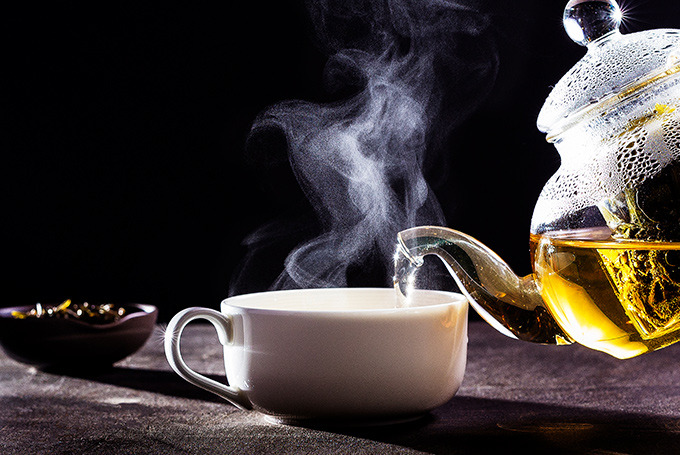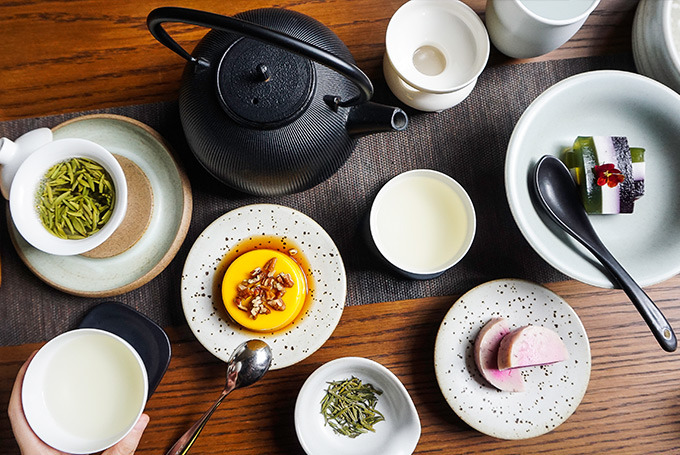The Best Tea Trends Of 2017
The year's best tea trends will make you forget all about your coffee habit
"The U.S. tea drinker is definitely becoming more modern. They're no longer just steeping with generic tea bags," Bin Chen, founder of Tea People and Boba Guys, says. Between NYC's growing roster of hip tea shops, like newly opened The Good Sort next door to hot spot Chinese Tuxedo to the expansion of MatchaBar, which is opening in L.A. soon, coffee shops feel like they're quickly going out of fashion.
Not only are these tea hubs the place to hang out, but as people become increasingly health-conscious, the tea industry continues to bring tea-curious drinkers ever more choices. Here are nine trends that have us leaving the coffee beans at the door as we enter the new age of tea.
① U.S.-Grown Tea
Almost all of the world's tea is grown in Asia, Africa and South America, but a small number of farms in the U.S. have started growing the shrub Camellia sinensis, whose leaves produce green, black and white teas. And cutting-edge restaurants, like San Francisco's Lazy Bear, are taking note. They've been sourcing tea from Golden Feather Tea farm for almost two years.
"The demand for domestically grown tea is just beginning, lagging behind demand for locally grown produce, fruit, and other foods and beverages," says Cassie Woolhiser, head of marketing at Minto Island Tea Company, a tea farm in western Oregon. "The tea tastes fresh. It's not as deep or complex as teas coming from Sri Lanka, China or Japan that are rich in tea history and culture, but it has a taste all its own, and that's pretty wonderful."
② Cold-Brew Tea
"Influenced heavily by the coffee world, cold-brewing is a sort of fail-proof steeping method that creates an amazing undiluted iced tea," Chen says. Tea People sells cold-brew tea, because it's a great way to extract flavor. "This is because the tea has a longer time to brew and allows for different tasting notes to be extracted. It's a really easy way to brew tea, and it eliminates any bitterness that you sometimes get from using too hot of water."
③ Bottled Matcha
When Graham Fortgang opened one of the country's first matcha cafés in 2014, he wanted to share what he calls "a better energy" with the world through drinks that actually taste good. Enter the now-ubiquitous matcha latte. In the last year, MatchaBar, which uses its own proprietary blend of matcha, started selling bottled matcha in flavors like apple ginger matcha, which you can buy online or at Whole Foods in NYC or L.A.
RELATED Steep Up Your Tea IQ "
"When we launched, it was the first bottled matcha on the market with a full serving of ceremonial-grade matcha," Fortgang says, which means there's two grams per serving and about as much caffeine as a shot of espresso. And now brands like Nature's Blueprint are following suit. Fortgang's opinion is the more matcha on the market the better. We couldn't agree more.
④ A Modern Approach to High Tea
Forget scones with clotted cream and make way for the new Brooklynized version of traditional British tea that involves the likes of sweet potato doughnuts and canelés made with fresh-milled flour, which you'll find at the just-opened Williamsburg Hotel. Serving a whole new kind of high tea, the hotel offers "teas from India, Japan, Korea, China and Taiwan sourced directly from the farmers," explain James Stuart, managing director of the hotel, and Stefen Ramirez, founder of Tea Dealers and the hotel's tea sommelier. Yes, tea sommeliers are part of the package.
⑤ Tea Pairings
Fine dining restaurants like Eleven Madison Park and Atera have been doing tea pairings with their tasting menus for a few years, and newcomer Olmsted is joining in. At Eleven Madison Park, tea expert Sarah Van Doren sees tea as just as important as wine, cocktails or coffee. The restaurant does tableside presentations and sources from a range of countries with the help of In Pursuit of Tea. You'll find everything from "handpicked green tea from Japan to aged pu-erh tea from China to numerous oolongs from Taiwan," Van Doren says.
"Fine dining has the ability to be both extremely complex and also incredibly simple. Just like with wine, the tea you choose can complement and add to your experience."
⑥ Expanding Palates
Pushing boundaries isn't reserved just for the world of fine dining either, explorer, mountaineer, writer and tea expert Jeff Fuchs, points out. Take pu-erh sheng, non-fermented green tea that has "long been regarded as vegetal brute in the tea world," Fuchs says. Where tea drinkers once favored ripe or cooked pu-erh shou instead, the bitter pu-erh sheng is now gaining traction.
"The attitude is changing as palates begin to understand that astringency and tangs of bitterness are not negatives, and that the way a tea finishes says as much as how it hits the mouth initially. Sheng pu-erhs' ability to age and develop in complexities is beginning to be more understood."
Joachim Hansen from Lazy Bear agrees. "Overall, I've seen people's tea palates expand a great deal in the last few years," he says. "Our tea importer, Haymen Da Luz, introduced me to a milk oolong tea this year. That was a style I was completely unfamiliar with: tangy, lactic acidity and rich, natural sweetness—incredible [when] paired with desserts. I expect we'll see more aged pu-erhs and unique oolongs and black teas coming up."
⑦ Highly Curated Lists
To help narrow down the ever-expanding options, tea shops, like Portland's burgeoning Tea Bar, aren't offering the encyclopedic lists of yore, but instead presenting a limited menu of highly curated picks. In addition to selling all-natural bubble tea, Tea Bar serves an always-changing short list of loose leaf. "Our menu is curated surrounding the notion of less is more, quality over quantity," Erica Indira Swanson, CEO and founder of Tea Bar, says.
⑧ Personalized Subscription Boxes
Taking it one step further, companies like Teabox are offering subscription boxes, which deliver a variety of fresh teas straight to your door. When Teabox launched in 2015, it was the world's first personalized tea-subscription service, and now others have followed. What sets Teabox apart, however, is its breadth—it has the largest selection of single-estate teas online—but also the machine learning that informs subscriptions. Customers take a quiz whereby Teabox identifies preferences, and over time, as customers share their feedback, the suggestions become even more tailored to the individual.
"This eliminates the chances of preconceived notions clouding the choice of judgments when it comes to selecting the teas," Kaushal Dugar, Teabox's founder and CEO, explains.
⑨ Nitro Tea on Tap
And just when you thought you had seen it all, the coffee trend that had you bouncing off the walls all summer has now found its way into the tea world, too. But this time, you can forget the fidgeting, because nitro tea makes for a much calmer caffeine high than its coffee counterpart. Alfred Tea Room in L.A. is experimenting with nitro tea, as is Chicago-based The Cafe at LeFlour.
"By using nitrogen to keg the cold brew, another dimension of flavor and taste emerges," Chen explains. "When drafted, it cascades like a Guinness beer with a foamy head. So the tea not only develops a creamy, frothy top layer, but becomes slightly effervescent."
Thai Iced Tea Boba from Tea Bar, Portland | Photo: Courtesy of Tea Bar
The Tea People Café | Photo: Courtesy of Tea People
Rose Tea from The Good Sort | Photo: Oleg March
Ingredients at Tea Bar, Portland | Photo: Courtesy of Tea Bar
Nitro Tea on Tap at Tea People | Photo: Courtesy of Tea People
Tea Bar in Portland, Oregon | Photo: Courtesy of Tea Bar








